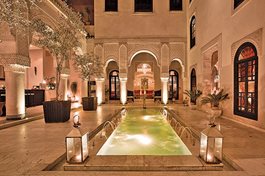 Morocco fans hotly debate what they like best about the colorful North African country: for some it’s the magnificent scenery of the Atlas Mountains; for others, it’s a trip to the souk to hunt for carpets, spices, and copper, while the foodies insist it’s the tanjine and mint tea, which keeps them coming back for more. But they all agree on one thing: when in Morocco, the best place to stay is a riad, that uniquely Moroccan structure, which combines form and function into one delightful dwelling.
Morocco fans hotly debate what they like best about the colorful North African country: for some it’s the magnificent scenery of the Atlas Mountains; for others, it’s a trip to the souk to hunt for carpets, spices, and copper, while the foodies insist it’s the tanjine and mint tea, which keeps them coming back for more. But they all agree on one thing: when in Morocco, the best place to stay is a riad, that uniquely Moroccan structure, which combines form and function into one delightful dwelling.
Riads have been a part of Moroccan life since the first millennium but their influences are far older, and the variety of these underscores Morocco’s position at the geographic cross-roads of civilization and the facility of her citizens to absorb and adapt styles and concepts from their neighbors. From the ancient Romans, riads derive their square footprint surrounding an open courtyard - what the Romans called an atrium domus - at the center of the house, with colonnaded terraces on each of the upper floors. True to a primary tenant of Islamic art and architecture, the floor is covered with beautiful tiled mosaics in geometric or floral patterns; the depiction of living beings is prohibited. The walls are plastered and decorated with exquisite wood or stone carvings of sayings from the Koran or more complex geometric patterns.
The courtyard of the riad is the central focus of the dwelling, and here the contribution of the Christian, Jewish and Muslim artisans from Andalusia in the 11th century is most prevalent: the courtyard symbolizes an oasis with lush plants and the all important fountain the center, which emphasizes the very great significance of water in Morocco’s desert climate. The word riad derives from the Arabic word for "garden," and a visit to even the most modest riad makes this abundantly clear.
The preservation of Morocco’s historic riads is a happy accident. In the 19th century, the French rulers of Morocco encouraged citizens to leave the old towns for new houses in European-style "nouvelles villes." Abandoned riads fell into disrepair and might have been demolished but for the rise in popularity of Morocco in the 1960s and 1970s for Europeans on the "alternative lifestyle" trail. Savvy real estate investors followed the lead of these bohemians, along with well-known celebrities and artists, snapping up old riads. Many of these have been turned into restaurants and hotels, and this has not only breathed new life into the medinas of cities such as Marrakesh and Essaouira, but has meant that the traditional handicrafts such as carving, tiling, and plastering are once more viable careers for parents to pass on to their children.
Three-night stays in Fez and in Marrakech at luxury riads is a key experience on Alexander + Roberts The Magic of Morocco.